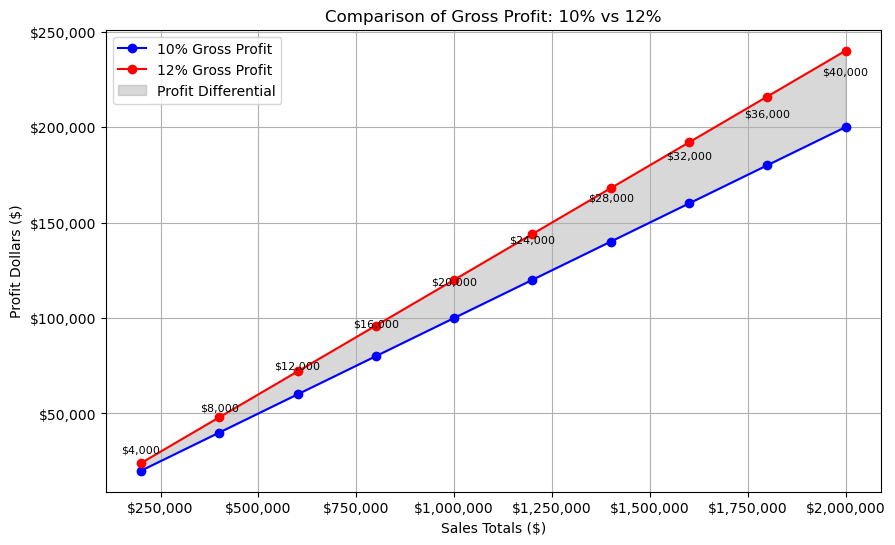Sales teams often struggle with effectively categorizing their customers, leading to inconsistencies in pricing strategies. One common issue occurs when a sales rep compares accounts within their own region rather than considering the broader market.
For example, imagine Customer ABC in a smaller market, spending $1 million annually. In this region, ABC is considered a large account, and the sales rep offers them the best possible pricing. Meanwhile, Customer XYZ, located in a larger, more competitive region, also spends $1 million annually, but because they rank as a mid-sized customer in that market, they receive higher pricing—typically 4-8% more than Customer ABC.
The problem arises when:
- Customer ABC enters the larger market and shares their pricing, introducing an artificially deflated price into the broader market.
- A larger customer moves into the smaller market, prompting the local rep to either match ABC’s lower pricing or undercut it further, driving prices down even more.
This dynamic leads to an unintended market-wide price compression, ultimately eroding margins and creating instability in pricing structures.

More granular pricing might be of benefit. Grouping customers and transactions into segments and types to create structured and scalable pricing policies, rather than setting individual prices for every customer or product. It is based on the concept of reference pricing, which suggests that customers are more or less price-sensitive depending on how often they buy a product and their familiarity with its price.
Since distributors handle thousands of SKUs and customers, manually setting individual prices is impractical. Instead, pricing should be determined by analyzing transaction types and customer segments to find patterns in purchasing behavior and price sensitivity. Although, later I will take a look at generating unique pricing profiles for all items using machine learning with PyTorch.
Customer Segments & Reference Pricing
A key element of scaling logic is reference pricing, which refers to a customer’s ability to recall a “fair” or market price for an item. The more frequently a customer buys a product, the more familiar they become with its price, making them more price-sensitive. Conversely, if a product is purchased less frequently, there is less price sensitivity, creating an opportunity for pricing adjustments.
Customers are divided into segments based on common purchasing behaviors (e.g., contractors, retailers, wholesalers). Pricing strategies are tailored to each segment rather than each individual customer. Items within a segment are analyzed to determine which are price-sensitive and which have pricing flexibility.
Unique Produrement Agents as a Sub-Customer Group
Another factor to consider with larger customers is that you are not dealing with one monolithic entity. Many large organizations have a team of procurement staff. There are general purchasing guidelines within many organzaations, but there is also personal preference associated to each individual purchaser.
Depending on their previous history, they may prioritize pricing certain type so products with a different level of aggression than some other people in the organziation. This represents a unique grouping and it may be tailored during purchasing negotiations. You may be able to exract more or less margin on a particular product because of these inherent biases. This might look like noise in your pricing data with the customer, but in effect it represents a distinct entity you can factor into your pricing model.
Transaction Types & Their Role in Pricing
Grouping analysis is used to rank SKUs by sales volume. Sales data is divided into 10% groupings (deciles), with each decile showing sales revenue and margin percentage. Lower sales volume items tend to be less price-sensitive, meaning they offer greater pricing flexibility. The goal is to increase margins on lower-volume items where price sensitivity is lower.

The insight here is that higher-volume SKUs tend to have tighter margins due to customer price sensitivity, while lower-volume SKUs can tolerate higher markups.
The Role of Scaling Logic in Pricing Strategy
When there is very little price differentiation, sales people will start to paint their customers with very big brushes.
Scaling logic provides a structured and analytical approach to pricing, ensuring that:
- >Price-sensitive items are priced competitively to maintain volume.
- Less price-sensitive items receive margin increases to boost profitability.
- Non-stock and low-volume items are priced to reflect higher processing costs.
This approach avoids the one-size-fits-all pricing mistakes of traditional models like price/volume analysis and pricing pocket waterfalls, which focus too much on overall account behavior rather than individual transactions.
By applying segment-based and transaction-based pricing, distributors can maximize profits without losing competitive advantage. This structured approach makes pricing more scalable, manageable, and profitable in the long run.
Price modeling as a classification model involves categorizing transactions, customers, or products into predefined segments based on patterns in purchasing behavior, price sensitivity, and market conditions. Instead of predicting an exact price, the model classifies a transaction into a pricing tier or segment (e.g., high, medium, low price bands) based on relevant features like order frequency, customer type, competitive landscape, and product demand. This structured approach enables more consistent and scalable pricing strategies by ensuring that similar transactions receive similar pricing, reducing inconsistencies and margin erosion.
